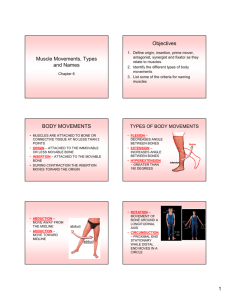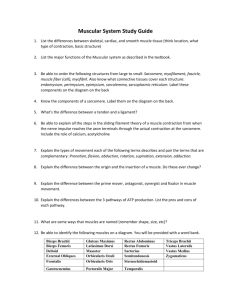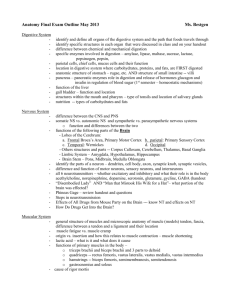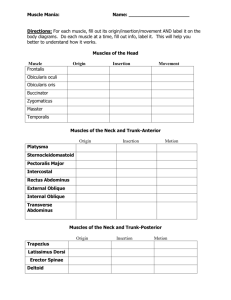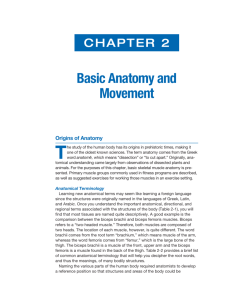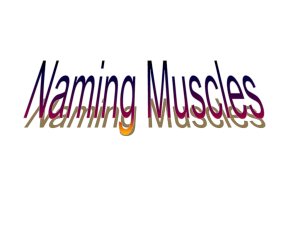Labs 3 + 4
advertisement
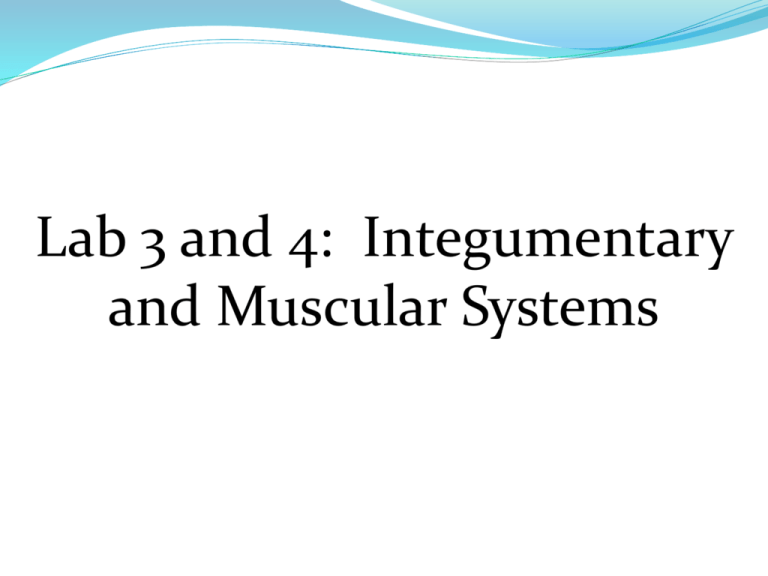
Lab 3 and 4: Integumentary and Muscular Systems Skeletal Muscle origin - what muscle attaches to for leverage, usually larger and more stationary bone than insertion insertion - what muscle attaches to for movement, usually a smaller bone than the origin and not stationary; the insertion is what the muscle acts upon and causes to move action - this is the type of movement that occurs Triceps Brachii – origin = proximal humerus, insertion = proximal ulna, action = elbow extention Biceps Brachii – origin = lateral scapula, insertion= proximal radius, action = flexes forarm Helpful hints for identification of skeletal muscles: Relative to direction of muscle fibers: rectus -fibers running parallel to the midline of the body or longitudinal axis of a bone transverse - fibers running at right angles or perpendicular to the midline or longitudinal axis of a bone oblique - fibers running obliquely (slanted or at a diagonal) to the midline of the body or longitudinal axis of a bone Relative to size: maximus – largest minimus – smallest longus – long brevis - short Relative to the number of origins: Biceps – 2 Triceps – 3 Quadriceps – 4 Relative to location of origin and insertion example: sternohyoid - sterno refers to the origin, which is the manubrium of the sternum and hyoid refers to the insertion, which is the hyoid bone. Relative to location of muscle example: brachioradialis - brachio refers to arm and radialis refers to the radius. This muscle runs along the radius of the forearm Relative to shape of the muscle example: deltoid - the muscle is triangular like the name implies Rhomboid Muscle Movements Movements that occur in the saggital plane: flexion/extension - waist (bend/extend) plantarflexion/dorsiflexion - ankle (point/ bend) Movements that occur in the frontal plane: abduction/adduction - arm/hip (movement away from midline/movement toward midline) inversion/eversion - foot (turn or roll foot in/ turn or roll foot out) Movements that occur in the transverse plane: rotation - neck pronation/supination - wrist (turn hand palm down/palm up antagonist muscle groups - one muscle works against the other (ex: biceps brachii and triceps brachii - when one muscle flexes the other extends) elevation/depression - upward movement/ downward movement (shrugging your shoulders) protraction/retraction - moving a part of the body away from the axis /opposite action (you protract your jaw when you grasp your upper lip with your lower teeth) tensor - makes more rigid sphincter - closes hole Abdominal Wall Muscles: External obliques Internal obliques Transverse Abdominus Rectus Abdominus "6-pack") Rotator Cuff Muscles ("SITS") ** ALL rotator cuff muscles: origin=scapula, insertion=humerus Supraspinatus Infraspinatus Teres Minor Subscapularis Quadriceps Femoris ("Quads") ** ALL quad muscles: insertion=tibial tuberosity via patellar ligament, action=knee extension Vastus Lateralis Vastus Medialis Vastus Intermedius Rectus Femoris Hamstrings ** ALL hamstring muscles: origin=ischium (the ischial tuberosities you "sit on"), action=knee flexion Biceps femoris Semimembranosus Semitendinosous
